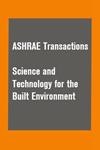Performance Assessment of a Real Water Source Heat Pump within a Hardware-in-the-Loop (HIL) Testing Environment
IF 1.6
4区 工程技术
Q3 CONSTRUCTION & BUILDING TECHNOLOGY
Science and Technology for the Built Environment
Pub Date : 2023-10-02
DOI:10.1080/23744731.2023.2261810
引用次数: 0
Abstract
Abstract:Over the last decade, the global fight against climate change through electrification has led to an increase in research on building heating, ventilation, and air conditioning (HVAC) systems that utilize intelligent control algorithms to provide demand-side grid service while also maintaining the thermal comfort of building occupants. As the pivotal point between building electricity consumption and indoor thermal comfort, high-efficiency electrical vapor-compression heat pumps are at the center of these emerging studies, and various grid-interactive and occupant-comfort control algorithms have been developed for them. The impact of these algorithms on heat pump operation and performance when subjected to different weather conditions, building loads, and grid requests calls for investigation and verification via experimental testing with actual heat pumps integrated with real-time building and grid responses. This study introduces a Water-Source Heat Pump (WSHP) Hardware-in-The-Loop (HIL) Test Facility that is the first of its kind. This testbed utilizes a 2-ton variable speed water-to-air heat pump that is capable of interacting with a virtual environment currently comprised of an EnergyPlus (E+) building simulation, an agent-based occupant behavioral model, and a single U-tube ground-loop heat exchanger (GLHE) model. Detailed descriptions of the testbed’s physical design and operation, virtual environement, as well as their mutual communication is provided. An uncertainty analysis is also performed under manufacturer specified heating and cooling design conditions. This analysis shows that the total load across the WSHP’s demand side heat exchanger, i.e., the sum of its latent and sensible components, can be measured with a relative uncertainty of ± 10.4 % and ± 3.6 % in cooling and heating mode respectively. The WSHP’s coefficient of performance (COP) can be measured with relative uncertainties of ± 10.4 % in cooling mode, and ± 3.7% in heating mode. A preliminary 24-hour experimental demonstration is then performed utilizing the DOE prototype small commercial office building model in E+. The simulation takes place in Atlanta, GA on the date of 08/26/15 from 12:00 AM to 11:59 PM using TMY3 weather data. . The results from this demonstration show that over the course of this experiment the simulated outputs of zone dry-bulb temperature, zone humidity ratio, and WSHP inlet water temperature can be tracked by testbed emulators up to a root mean squared error (RMSE) of ± 0.27 °C, ± 0.376 g/kg, and ± 0.85 °C respectively. The WSHP’s dynamic behavioral characteristics and performance are also captured, and correspond well with the authors’ previous understanding of heat pump efficiency as a function of evaporator and condenser fluid inlet conditions respectively.Keywords: Water-Source Heat PumpHardware-in-the-LoopExperimentalDisclaimerAs a service to authors and researchers we are providing this version of an accepted manuscript (AM). Copyediting, typesetting, and review of the resulting proofs will be undertaken on this manuscript before final publication of the Version of Record (VoR). During production and pre-press, errors may be discovered which could affect the content, and all legal disclaimers that apply to the journal relate to these versions also. Acknowledgement真实水源热泵在半实物(HIL)测试环境下的性能评估
摘要:在过去的十年中,通过电气化应对气候变化的全球斗争导致建筑采暖,通风和空调(HVAC)系统的研究增加,这些系统利用智能控制算法提供需求方电网服务,同时保持建筑居住者的热舒适。高效电蒸汽压缩热泵作为建筑用电量与室内热舒适之间的关键节点,是这些新兴研究的中心,针对其开发了各种网格交互和居住者舒适控制算法。当受到不同天气条件、建筑负荷和电网要求的影响时,这些算法对热泵运行和性能的影响需要通过与实时建筑和电网响应相结合的实际热泵的实验测试进行调查和验证。本研究介绍了水源热泵(WSHP)硬件在环(HIL)测试设备,这是同类设备中的第一个。该试验台使用了一个2吨的可变速度水-空气热泵,该热泵能够与当前由EnergyPlus (E+)建筑模拟、基于代理的居住者行为模型和单u管地环路热交换器(GLHE)模型组成的虚拟环境进行交互。详细介绍了试验台的物理设计与运行、虚拟环境以及它们之间的相互通信。在制造商指定的加热和冷却设计条件下也进行了不确定性分析。分析结果表明,在制冷模式和制热模式下,水源热泵需求侧换热器的总负荷,即潜热分量和显热分量之和的相对不确定度分别为±10.4%和±3.6%。制冷模式和制热模式的相对不确定度分别为±10.4%和±3.7%。然后利用DOE原型小型商业办公楼模型在E+中进行了初步的24小时实验演示。模拟发生在亚特兰大,乔治亚州的日期08/26/15从12:00 AM至11:59 PM使用TMY3天气数据。实验结果表明,在整个实验过程中,试验台仿真器可以跟踪区域干球温度、区域湿度比和WSHP进水温度的模拟输出,均方根误差(RMSE)分别为±0.27°C、±0.376 g/kg和±0.85°C。本文还分析了热泵系统的动态行为特征和性能,并与作者之前对热泵效率分别作为蒸发器和冷凝器流体进口条件的函数的理解相吻合。关键词:水源热泵硬件在环实验免责声明作为对作者和研究人员的服务,我们提供这个版本的接受手稿(AM)。在最终出版版本记录(VoR)之前,将对该手稿进行编辑、排版和审查。在制作和印前,可能会发现可能影响内容的错误,所有适用于期刊的法律免责声明也与这些版本有关。确认
本文章由计算机程序翻译,如有差异,请以英文原文为准。
求助全文
约1分钟内获得全文
求助全文
来源期刊

Science and Technology for the Built Environment
THERMODYNAMICSCONSTRUCTION & BUILDING TECH-CONSTRUCTION & BUILDING TECHNOLOGY
CiteScore
4.30
自引率
5.30%
发文量
78
期刊介绍:
Science and Technology for the Built Environment (formerly HVAC&R Research) is ASHRAE’s archival research publication, offering comprehensive reporting of original research in science and technology related to the stationary and mobile built environment, including indoor environmental quality, thermodynamic and energy system dynamics, materials properties, refrigerants, renewable and traditional energy systems and related processes and concepts, integrated built environmental system design approaches and tools, simulation approaches and algorithms, building enclosure assemblies, and systems for minimizing and regulating space heating and cooling modes. The journal features review articles that critically assess existing literature and point out future research directions.
 求助内容:
求助内容: 应助结果提醒方式:
应助结果提醒方式:


